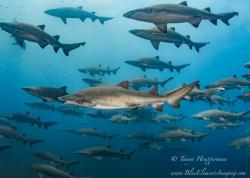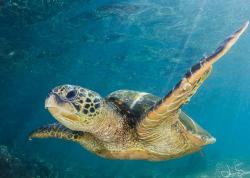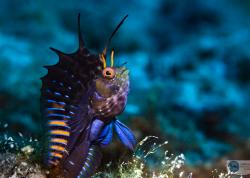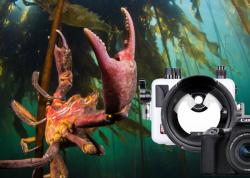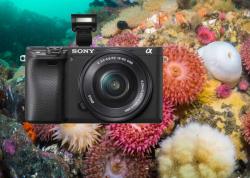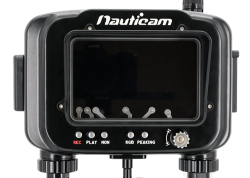Wolf Eels: A Face Only a Mother Could Love
There are a lot of ugly fish in the sea. Which one is the ugliest? Well, it’s really hard to say. There are a lot. So many, in fact, this is a frequent topic of debate among divers, scientists, and late-night TV hosts. Having scientifically identified thousands upon thousands of fish at sea in the North Pacific, it’s still quite hard for me to pick my top contenders. But without a doubt, wolf eels (Anarrhichthys ocellatus) rank in the top five. To me, wolf eels resemble the face of an old man who spent a little too much time under the sun, died, and then reanimated as a zombie.

Neither Wolf nor Eel
Found to depths of 740 feet in the North Pacific from Japan to Southern California, wolf eels are neither wolf nor eel. They are fish. But don’t call them wolf fish – that’s something else. Wolf eels can reach a remarkable length of 7ft 10 inches and 41 pounds. Although they aren’t a true eel, they fill a similar niche. Wolf eels tend to live in caves or cracks between boulders and feed on crustaceans (crab and shrimp), as well as urchins, mussels, clams, and the occasional fish. Their sharp canines are perfect for crushing through shells.
Identified by their often brilliant orange color, juvenile wolf eels remain pelagic for up to 2 years and slowly settle benthically into nearshore reefs to find a proper den. They have been known to share dens with giant pacific octopus, lingcod, rockfish, and sculpin. But octopus have also been known to eradicate pesky wolf eels.
Love is blind (clearly)
Despite their frightening appearance, wolf eels just want to be loved. In fact, of all the fish I have ever had the pleasure of diving with, wolf eels are some of the most dedicated lovers. Living for at least 28 years, many wolf eels will mate for life. You can often find them coinhabiting a small cave, day after day, carefully taking care of their eggs and taking turns to venture out to feed. The females will often be smaller and browner in appearance, with males larger and grayer. During casual observation, I have seen large males come halfway out of their den to “fend off” intrusive divers and block their mate and eggs from sight.
To Feed or Not to Feed
But in reality, wolf eels are quite docile, friendly, and very curious. They are easily habituated to divers. As such there is some controversy over divers feeding them. At some popular dive sites, wolf eels will casually exit their dens and approach a diver to see if they have any food. Some wolf eels will even let a cautious diver pet them. I don’t recommend doing this, as petting fish removes a protective slime coating which keep them safe from disease. While they never attack divers for food, feeding encourages the wolf eels to expect food from divers and not go hunting themselves.
Photographing Wolf Eels
Where to Look
Wolf eels can be a joy to photograph or a big frustration. They each have their own personality, and some are more cautious than others. Much of your success can depend on how many divers frequent the site. Sites where wolf eels don’t often see divers will be more troublesome, as the wolf eels tend to be a little more wary of divers. In Southern California, wolf eels are found at the deeper edges of recreational limits (often deeper than 100 feet) in relatively cold water. In the Pacific Northwest, they are found shallower (starting at about 40 feet), as the water is generally cold enough for them to be happy. The best place to search is at the bottom of medium to large size boulders or inside small crevices on walls. Wolf eels are often found tucked deep into their cave, but they can be coaxed out by their natural curiosity.

Tips for Lighting
Due to their habitat, lighting wolf eels can be quite tricky. If you are shooting macro, be sure to position your strobe(s) so that it lights the inside of the cave where the wolf eel is hiding. I find that a snoot is often easier and less intrusive to use for lighting small caves. Proper lighting with a macro photo can sometimes elucidate a green and yellow sheen on their eyes – adding some character to the photo.

It is very tricky to light wolf eels with a wide lens. You’ll almost always need them to stick their head out of their den or come completely out. It can be impossible to get close enough to get a good photo when they are in their den. It’s easy to overexpose their light grey bodies with the dark green water around them. I try to pull my strobes back and bring them in close to the camera. Then I turn the strobe power down to keep the greys in the eel properly exposed and further reduce backscatter. If often helps to bump up your ISO so you can keep the aperture small enough to get a good depth of field. I find that having a diver in the background is nice to provide perspective on the wolf eel’s size.
A few final tips
1. Wolf eels don’t breathe in and out like morays, but they do open their mouths from time to time. Properly timed, you can capture some of those massive canine teeth.
2. Use a red light to focus. This helps keep wolf eels interested in you and not reeling in from being blinded by white light.
3. If you are shooting wide, I have found that when they are habituated to divers, they can be very interested in their reflection in the dome. They’ll try to size themselves up and then back off.
Wolf eels may be ugly, but it’s not just their mothers that love them. Like many dedicated divers in the Pacific Northwest, if you learn to love them, the eels will love you right back.
Additional Reading:
RECOMMENDED ARTICLES
SUPPORT THE UNDERWATER PHOTOGRAPHY GUIDE:
The Best Service & Prices on u/w Photo Gear
 Visit Bluewater Photo & Video for all your underwater photography and video gear. Click, or call the team at (310) 633-5052 for expert advice!
Visit Bluewater Photo & Video for all your underwater photography and video gear. Click, or call the team at (310) 633-5052 for expert advice!
The Best Pricing, Service & Expert Advice to Book your Dive Trips
 Bluewater Travel is your full-service scuba travel agency. Let our expert advisers plan and book your next dive vacation. Run by divers, for divers.
Bluewater Travel is your full-service scuba travel agency. Let our expert advisers plan and book your next dive vacation. Run by divers, for divers.










